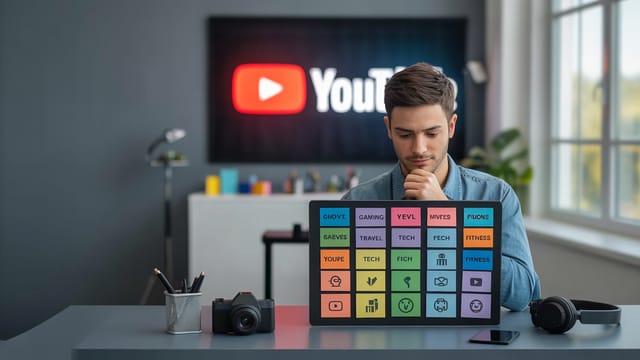
Ready to get your next 10,000 subscribers?
Join thousands of creators who use Subscribr to create faster, better YouTube videos.
Tired of pumping out videos that feel like echoes in a crowded room? Does the thought of hitting record trigger 'creator's block' because you feel like everything has been done? You're not alone. Standing out on YouTube, especially in established niches, is one of the biggest challenges advanced creators and strategists face. The secret isn't always about being the best at what you do, but often about being the only one doing exactly what you're doing. This requires a strategic approach to finding and filling YouTube market gaps.
Identifying these underserved areas isn't just about novelty; it's about strategic positioning. When you successfully target a high-demand, low-supply topic, you establish authority, attract a highly engaged niche audience, and build brand loyalty that can lead to significant monetization opportunities.
But how do you find topics no one is covering on YouTube? What exactly is a content gap analysis for YouTube, and how can you actually be original in a space with billions of videos? Let's dive deep.
The Core Concept: Demand-Supply Arbitrage on YouTube
At its heart, finding YouTube market gaps is about understanding the principle of Demand-Supply Arbitrage, as highlighted in expert strategies. Supply is the volume of videos available on a topic, and demand is the audience actively seeking that content. Most creators flock to high-demand, high-supply areas – the obvious, popular topics. Growth becomes a fierce battle against countless competitors.
The opportunity lies in the high-demand, low-supply gaps. These are topics or angles that a significant audience wants to see, but few creators are actually making content about. Identifying and creating videos for these voids allows you to capture audience attention with less competition.
Your goal isn't just to make any video, but to make the video the audience wants but can't easily find.
Moving Beyond the Obvious: Finding Underserved YouTube Topics
Finding topics no one is covering requires moving beyond simple keyword research and adopting a more nuanced approach. While keyword tools can show you what people are searching for, they don't always reveal how well those topics are being addressed, or the specific angles that are missing.
Here are systematic methods to uncover those hidden opportunities:
1. Deep Audience Research: Listen to the Whispers
Understanding your target audience is paramount. Go beyond basic demographics. What are their frustrations? What problems are they trying to solve that current YouTube content isn't adequately addressing? Where do they hang out online (forums, Reddit, Facebook groups, Discord servers)? What questions are they constantly asking?
Actively listening in these communities, even if you don't have a large audience yet, provides a direct line to unmet demand. Look for recurring questions, complaints about existing content, or discussions that reveal a lack of clear information on a specific sub-topic. These are goldmines for identifying underserved areas.
Subscribr's Audience Persona generation, built on analyzing your channel's content and performance data, can provide a strong starting point for understanding who you're talking to. Supplement this with direct community engagement.
2. Analyzing Top Performers (and Their Comment Sections)
Studying successful channels in your niche isn't just for competitive analysis; it's a key method for content gap analysis. Look at their most popular videos to understand what resonates broadly. But then, dig into the comment sections of both popular and less popular videos.
What are viewers praising? What are they criticizing? What follow-up questions are they asking that the video didn't answer? What related topics do they wish the creator would cover? Comments often directly articulate unmet needs and reveal specific angles or depths of coverage that are missing from even popular content.
Competitive intelligence features, like those in Subscribr's Video Breakdown Tool and Channel Intelligence system, can help you quickly analyze top videos and channels to identify patterns and potential areas creators aren't focusing on.
3. Identifying New Viral Creators and Outlier Videos
Don't just look at the established giants. Pay close attention to newer creators who experience sudden viral success or have "outlier" videos – videos with view counts significantly higher than their subscriber count or channel average.
These outliers often indicate that the creator stumbled upon a high-demand topic or angle that resonated strongly. By analyzing what made that specific video pop, you can identify potential gaps or emerging trends before they become saturated. Ask yourself: What specific problem did this video solve? What unique perspective did it offer? How did it package the information differently?
Subscribr's Outlier Score calculation can help you quickly spot these high-performing videos, both on your own channel and others, allowing you to analyze their success factors.
4. Looking at Underserved Niches Within Your Niche
Sometimes the market gap isn't a missing topic, but a missing audience or angle within an existing topic. For example, in a broad "fitness" niche, are there specific demographics (e.g., fitness for remote workers, fitness for new parents) or specific goals (e.g., improving posture for desk jobs, building endurance for hiking) that aren't being addressed with tailored content?
Or perhaps a specific technique, playstyle (in gaming), or sub-discipline within your field is perceived as unpopular or too difficult, leading to a lack of accessible, high-quality content. Becoming the go-to source for this specific, underserved segment can be a powerful strategy.
5. Leveraging Your Unique Perspective and Skills
How can you be original on YouTube? Often, originality comes from combining your unique experiences, skills, and personality with market demand. What is your distinct perspective on a topic? Do you have a specific skill or background that allows you to explain something in a way others can't?
Look for areas where your personal passion or expertise intersects with potential audience needs. What content would you want to see that doesn't exist? As one creator strategy suggests, identifying content you personally desire but can't find can point directly to an underserved area. Your unique take on a topic can be the "low supply" to an existing "high demand."
Performing a Content Gap Analysis for YouTube
A content gap analysis isn't a one-time event; it's an ongoing process of research and observation. For YouTube, it involves systematically:
- Mapping the Existing Landscape: Identify the major players and dominant topics/formats in your niche. What content is abundant?
- Identifying Audience Needs: Use the methods above (community listening, comment analysis, direct audience interaction) to understand what viewers are looking for or struggling with. What demand exists?
- Pinpointing the Voids: Compare the existing content (supply) with the audience needs (demand). Where are the significant overlaps between high demand and low supply? What specific questions are left unanswered? What angles are unexplored? What formats are missing?
- Evaluating Opportunity: Assess the potential of the identified gaps. Is there a large enough audience for this specific niche or topic? Can you realistically create high-quality content to fill this gap with your resources and expertise?
Subscribr's Research Phase tools, allowing you to import and analyze content from URLs, YouTube transcripts, and documents, can be invaluable for systematically mapping the existing landscape and gathering information on competitor content.
From Gap to Idea: Systematic Idea Generation and Validation
Once you've identified potential market gaps, the next step is translating those insights into concrete video ideas and validating their potential.
Idea Generation: Filling the Void with Your UVP
With a market gap in mind (e.g., "beginners struggle to understand advanced photo editing techniques"), brainstorm video ideas that directly address this need. How can you explain those techniques in a simple, accessible way? What specific software or concepts are most confusing?
Focus on your Unique Value Proposition (UVP). What makes your approach to filling this gap special? Is it your teaching style, your specific experience, your humor, or a unique framework you've developed? Your UVP is how you differentiate yourself even when addressing a known demand.
Idea Validation: Does the Audience Really Want It?
Before investing significant time in scriptwriting and production, validate your idea. This doesn't require a massive audience. You can:
- Test Titles and Thumbnails: Create potential titles and thumbnails for your idea and get feedback from peers, online communities where your target audience hangs out, or even run simple polls on social media if you have a small following. Do they generate curiosity? Are they clear about the topic?
- Discuss the Idea: Talk about your potential idea in online communities or with your existing audience (if any). Does it spark interest? Do people confirm they have this problem or are looking for this information?
- Analyze Search Volume (with Caution): Use keyword tools to see if there's search volume around related terms, but remember this is only one piece of the puzzle. Low search volume doesn't always mean low demand; it might mean people don't know the right terms, or the demand exists in communities rather than search.
- Look for Outlier Patterns: As mentioned earlier, if you see outlier videos addressing a similar theme (even in a different niche), it's a strong signal of latent demand.
Subscribr's Title Generation System and Hook Creation Tools can help you package your validated ideas effectively to maximize click-through rates once the video is produced. Subscribr's Chat-to-Script conversion can even help turn brainstorming sessions and validation discussions directly into outlines.
Monetization and Brand Loyalty: The Rewards of Filling Gaps
Successfully identifying and consistently creating content for market gaps has significant long-term benefits beyond just getting views.
- Establishing Authority: By becoming the go-to source for an underserved topic, you quickly establish authority and expertise in that specific area. This makes you a trusted resource for viewers.
- Attracting a Highly Engaged Niche Audience: Audiences who find content specifically tailored to their unmet needs are often highly engaged, loyal, and appreciative. They are more likely to watch your videos fully, interact in comments, and return for more.
- Stronger Monetization: An engaged, niche audience is incredibly valuable. They are often more receptive to recommendations (affiliate marketing), more likely to purchase your own products or services, and more attractive to brands seeking to reach that specific demographic. Filling a gap can create a direct path to monetization that is often more effective than competing in a crowded space.
- Building a Distinct Brand: Focusing on a specific, underserved niche helps you build a clear, memorable brand identity. Viewers know exactly what to expect from your channel, fostering loyalty and making it easier to attract new subscribers who fit your target demographic.
Subscribr's comprehensive platform, from its Channel Management System and Audience Intelligence to its Script Building Pipeline and Content Optimization tools, is designed to help creators systematically execute on the strategies required to identify gaps, create high-value content, and build a thriving channel by leveraging data and AI-powered workflows.
Conclusion
Escaping the cycle of creator's block and the frustration of blending into the background starts with a shift in perspective. Instead of asking "What popular topic can I cover?", ask "What valuable content is my audience missing?" By applying a systematic approach to content gap analysis and focusing on the principle of Demand-Supply Arbitrage, you can uncover unique video ideas that not only stand out but also build a dedicated audience and unlock significant monetization potential. It requires research, observation, and a willingness to explore the underserved corners of your niche, but the rewards – a loyal audience, a distinct brand, and sustainable growth – are well worth the effort.
Start by listening intently to your potential audience and analyzing the existing landscape with a critical eye. The gaps are there; you just need to know how to look for them. Tools like Subscribr can provide the data and workflow to support this strategic process, turning insights into actionable content plans.





